Ijraset Journal For Research in Applied Science and Engineering Technology
- Home / Ijraset
- On This Page
- Abstract
- Introduction
- Conclusion
- References
- Copyright
Comparative Material Selection of Battery Pack Casing for an Electric Vehicle
Authors: Gautam Kulkarni, Arya Mahajan, Anay Maheshwari
DOI Link: https://doi.org/10.22214/ijraset.2023.56595
Certificate: View Certificate
Abstract
This paper discusses the battery pack thermal management components for electric vehicles that are necessary for the batteries to operate effectively in all weather. Due to their high energy density and long-life cycle, lithium-ion (Li-ion) battery cells are utilized in electric vehicles. Operating temperature affects the Li-ion battery\'s performance and lifespan. Moreover, this project aims to review materials for electric vehicles battery pack casing by incorporating proper thermal management required for efficient working of batteries in any climatic conditions. Lithium-ion (Li-ion) battery cells are being used for electric vehicles because they having high density of energy and long-life cycle. Higher operating temperatures lengthen battery life and boost capacity. The use of air, water and phase change materials (PCMs) as thermal management techniques are explored and contrasted. Following comparison, a useful battery pack casing for temperature management system is discussed. In this study, we explore the phenomena of heat generation and temperature problems of Li-ion batteries.
Introduction
I. INTRODUCTION
In recent times, electric vehicles are becoming more attractive and popular due to their attributes including reduced energy loss, less pollution, and environmental friendliness, electric vehicles are currently becoming more appealing and well-liked. Because of their high specific power and specific energy density, many battery types, including lithium-ion (Li-ion), lead-acid, and nickel metal hydride (Ni-MH), are employed in electric vehicle applications.
Li-ion batteries are more commonly used in electric and hybrid vehicles than other types of batteries since they have great power, are lightweight, and don't need to be charged continuously.
When the temperature of a battery exceeds a certain threshold, it can lead to an uncontrolled and highly intense reaction. Moreover, when a battery reaches a point where it releases a significant amount of heat, approximately 12% of the total heat emitted can cause nearby batteries to experience a potentially hazardous explosion. This situation is particularly critical when dealing with lithium-ion batteries. Consequently, the implementation of a battery thermal management system (BTMS) becomes imperative for lithium-ion battery systems, especially at elevated temperatures.
The battery thermal management system (BTMS) serves two primary purposes:1) maintaining batteries in optimal operating conditions to enhance their electrical performance and prolong their lifespan, and 2) preventing the occurrence of excessive heat dissipation, thereby enhancing safety. Commonly employed heat transfer mechanisms in battery-powered systems include air conditioning, liquid cooling, and phase change (PCM).
Hence, the primary objective of this study is to explore various materials and technologies related to battery thermal management, as documented in existing literature, that can be applied to the latest electric vehicles.
A. Available Battery Pack Design
The cells are classified based on their form factor into the following categories:
- Cylindrical Cell: A battery that features a cylindrical casing and connecting elements. Cylindrical lithium-ion cells have a long-standing history, with the invention of the 18650 cylindrical cells by SONY in 1992. Cylindrical cells exhibit consistent performance, which contributes to battery packs with cylindrical cells offering superior thermal performance. The primary reasons for the widespread adoption of cylindrical cells in power batteries today are their lower cost and better heat dissipation capabilities. However, due to their relatively low energy density, achieving desired energy and power targets necessitates connecting thousands of 18650 cells in parallel and series. This increases the complexity of the internal structure of the battery pack and the battery management system.
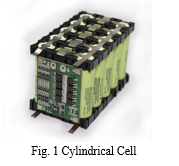
2. Pouch Cell: A battery characterized by a flexible composite film shell and connecting elements. Pouch cells utilize an aluminium-plastic film as the outer shell and feature a laminated structure inside, allowing for customization of size and shape based on specific customer requirements. Compared to prismatic cells of the same capacity, pouch cells exhibit an average weight reduction of approximately 20%, while offering nearly 50% higher capacity than prismatic cells of the same volume. Moreover, the aluminium-plastic film of pouch cells is designed to expand or rupture only in the event of a safety hazard, minimizing the likelihood of explosions and thereby enhancing the overall safety of battery packs.
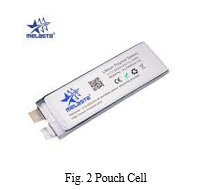
3. Prismatic Cell: A battery characterized by a rectangular casing and connecting elements. Prismatic battery cells typically feature an aluminium alloy shell and employ square winding or stacked sheet configurations internally. The higher hardness of the shell provides superior protection compared to pouch cells that use an aluminium-plastic film. Prismatic cells do not adhere to a standardized format and can be customized to various sizes and larger capacities based on customer requirements, thereby reducing the complexity of the battery pack's structure and overall volume.
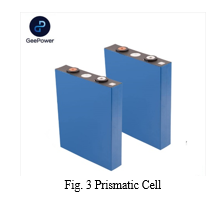
III. METHODOLOGY/EXPERIMENTAL
A. Theory
Battery Pack Housing Material
The most commonly available material for manufacturing a battery pack housing is Aluminum.
The battery pack housing is often made of aluminum due to its favorable characteristics and suitability for the purpose. Here are some reasons why aluminum is commonly used:
- Lightweight: Aluminum is a lightweight metal, which is advantageous for battery packs. It helps reduce the overall weight of the vehicle or device, thereby improving fuel efficiency in electric vehicles and increasing portability in portable electronic devices.
- Strength and Durability: Aluminum has excellent strength-to-weight ratio, meaning it offers high strength while being relatively lightweight. This property allows it to withstand various mechanical stresses and provides durability to the battery pack housing, protecting the batteries inside.
- Corrosion Resistance: Aluminum naturally forms a thin layer of oxide on its surface, which acts as a protective barrier against corrosion. This oxide layer helps shield the battery pack housing from environmental factors such as moisture, humidity, and chemicals, ensuring the longevity of the batteries.
- Thermal Conductivity: Aluminum has good thermal conductivity, meaning it efficiently dissipates heat generated during battery operation. This property aids in maintaining optimal temperature levels within the battery pack, preventing overheating and prolonging battery life.
- Ease of Manufacturing: Aluminum is relatively easy to work with during manufacturing processes such as casting, extrusion, and machining. It can be formed into complex shapes and structures, allowing for design flexibility in battery pack housings.
While aluminum has several advantages as a material for battery pack housing, it also has a few drawbacks to consider:
a. Cost: Aluminum can be more expensive than other materials, such as steel or certain plastics. The higher cost of aluminum may impact the overall production cost of the battery pack and, consequently, the final product's price.
b. Limited Protection Against Electromagnetic Interference (EMI): Aluminum is not an ideal shield against electromagnetic interference. In certain applications where EMI shielding is crucial, additional measures or coatings may be required to prevent interference with sensitive electronic components.
c. Lower Rigidity Compared to Some Materials: While aluminum is lightweight, it may not offer the same level of rigidity as materials like steel or carbon fiber composites. In applications where high structural integrity is necessary, alternative materials may be preferred.
d. Potential Galvanic Corrosion: When aluminum comes into contact with certain metals, particularly in the presence of an electrolyte like moisture, it can experience galvanic corrosion. This occurs when there is a difference in electrical potential between the aluminum and the other metal, leading to accelerated corrosion of the aluminum. Proper insulation and design considerations can help mitigate this risk.
e. Thermal Expansion: Aluminum has a relatively high coefficient of thermal expansion. This means that it expands and contracts more significantly with temperature changes compared to other materials. In some instances, this thermal expansion may require careful design considerations to ensure proper fit and avoid potential issues with the battery pack's structural integrity.
f. Recycling Challenges: While aluminum is highly recyclable, the recycling process itself can be energy-intensive. The collection, sorting, and processing of aluminum scrap require specialized facilities and equipment. If not properly recycled, aluminum waste can contribute to environmental concerns.
To address these issues, we have put out the hypothesis of employing a polymer material, which offers strength comparable to or slightly greater than aluminum and satisfies all other requirements for an effective battery pack housing. We are resolved to use additive manufacturing, or 3-D printing, of the case in order to address manufacturing challenges and costs. This technique is made possible by the polymeric material used in the case.
B. Material selection and Material properties
In order to achieve research goals and the safest possible outcome for a battery pack casing made up of polymeric material we selected four materials i.e., PLA (Polylactic Acid), ABS (Acrylonitrile Butadiene Styrene), PETG (polyethylene terephthalate glycol) and FR-ABS (Flame-Retardant Acrylonitrile Butadiene Styrene).
The motive behind selecting these materials for a battery pack casing was:
- Flexibility: 3D printing allows for complex geometries and customization options. This flexibility enables optimized space utilization and efficient integration of components.
- Weight Reduction: 3D Printed casing is a relatively lightweight, which can help reduce the overall weight of the battery pack. This is particularly advantageous for electric vehicles, where weight reduction translates to improved efficiency and increased mobility.
- Impact Resistance: 3d printed material offers good impact resistance, providing protection to the batteries within the pack. This is particularly important for applications where the battery pack may be subject to mechanical stresses or accidental impacts.
- Cost-Effectiveness: 3D printing can potentially reduce costs by minimizing the need for additional tooling or moulds. It allows for the production of complex shapes in a single manufacturing step, eliminating assembly processes and reducing production time.
- Rapid Prototyping and Iteration: 3D printing enables rapid prototyping and iterative design improvements. It allows designers and engineers to quickly test different designs, validate functionality, and make adjustments as needed. This iterative process helps optimize the battery pack design for performance, manufacturability, and safety.
To understand the properties of these materials and choose the best which fits the job we had to undergo few processes and test and check for the viability of the manufacturing it on a huge scale. We conducted UTM tests to understand the values the tensile strength, flexural strength, impact resistance and compression strength. Moreover, to get an idea of the thermal properties we performed Flame tests for each and every material.
???????C. Preparation of specimen and testing.
The AM process of Fused Deposition Modeling (FDM) was used to prepare the test specimens. This process is described as “Material extrusion”. According to the standard definition, material extrusion is an AM process in which the material is selectively dispensed through a heated nozzle. A test specimen was designed abiding by the ASTM D638 standards of tensile testing. The CAD model of specimens was created using SolidWorks 2020. Then the CAD model was converted to an STL (Stereolithography) file. After that, the model was prepared for 3D printing using Ultimaker Cura 4.6 software. The specimens were printed on a desktop FDM 3D printer.

- Printing Parameters
The purpose of preparing specimens is their tensile strength testing depending on the material, infill density, infill pattern and orientation of the printed specimen in the build area. Other parameters of 3D printing are the same for all specimens, as it is shown in Table below.

The same design of the specimen was printed with printing pattern of diagonal lines and infill percentage 100%, using the selected four materials i.e., PLA (Polylactic Acid), ABS (Acrylonitrile Butadiene Styrene), PETG (polyethylene terephthalate glycol) and FR-ABS (Flame-Retardant Acrylonitrile Butadiene Styrene).

Subsequently, tensile testing was carried out on the UTM (Universal Testing Machine) and Flame-retardant test. The inferred results are stated below in the table for each and every material.
|
PLA (Polylactic Acid) |
|
|
Printing Bed Temperature |
50°C |
|
Nozzle Temperature |
200°C |
|
Ultimate Tensile Strength |
55.38 N/mm^2 |
|
Yield Stress |
36.64 N/mm^2 |
|
Elongation |
0.30 mm |
|
Flame Retardant Rating |
UL 723 |
Table 2: Properties for PLA
|
ABS (Acrylonitrile Butadiene Styrene) |
|
|
Printing Bed Temperature |
100°C |
|
Nozzle Temperature |
245°C |
|
Ultimate Tensile Strength |
38.49 N/mm^2 |
|
Yield Stress |
31.42 N/mm^2 |
|
Elongation |
0.76 mm |
|
Flame Retardant Rating |
UL 723 |
Table 3: Properties for ABS
|
PET-G (polyethylene terephthalate glycol) |
|
|
Printing Bed Temperature |
50°C |
|
Nozzle Temperature |
240°C |
|
Ultimate Tensile Strength |
51.68 N/mm^2 |
|
Yield Stress |
54.54 N/mm^2 |
|
Elongation |
- |
|
Flame Retardant Rating |
NFPA 701: |
Table 4: Properties for PETG
|
FR-ABS (Flame-Retardant Acrylonitrile Butadiene Styrene) |
|
|
Printing Bed Temperature |
100°C |
|
Nozzle Temperature |
250°C |
|
Ultimate Tensile Strength |
42.33 N/mm^2 |
|
Yield Stress |
40.30 N/mm^2 |
|
Elongation |
0.20mm |
|
Flame Retardant Rating |
UL 94, HB |
Table 5: Properties for FR-ABS
Standard Values of Test conducted for an aluminum specimen
|
ALUMINIUM |
|
|
Ultimate Tensile Strength |
54.78 N/mm^2 |
|
Yield Stress |
52.82 N/mm^2 |
|
Elongation |
3.00 mm |
|
Flame Retardant Rating |
UL 94 |
Table 6: Properties for Aluminium
Considering all these properties we plotted a decision matrix taking into account the criteria’s such as Mechanical Properties, Thermal Properties, Manufacturing Ease, Material Cost, Availability and Environmental Impact that affect a battery pack housing.
???????D. Decision Matrix Development
A decision matrix is a tool used in decision making processes. It provides a structured for evaluating available options by systematically assessing importance of each criterion and weigh them against each other.
The steps while making decision matrix:
- Identify the Decision to be Made: We wanted to select the best material for battery pack casing for electric vehicles.
- Determine the Criteria: The criterions considered are Mechanical Properties, Thermal Properties, Chemical Properties, Manufacturing Ease, Material Cost, Availability, and Environmental Impact.
- Assign Weights to Criteria: Determine the relative importance or priority of each criterion. Assign a weight or percentage to each criterion to indicate its significance in the decision-making process. The weights should add up to 100% or 1.0.
- List the Options: Identify the different options or alternatives that are available for consideration. List them as rows in the decision matrix.
- Evaluate Options Against Criteria: Depending on the available data we scored all the criteria out of 5 based on how the criteria are are fulfilled by the material.
- Calculate Weighted Scores: Multiply the scores for each criterion by the corresponding criterion weight. Sum up the weighted scores for each option to obtain a total weighted score for a material.
- Analyze and Compare Results: We compare the total weighted scores for all the materials to understand which material gives better results.
- Make a Decision: Consider the results of the decision matrix along with any other relevant factors. Use the information from the decision matrix as a guide to make an informed decision for selecting the best possible material for battery pack casing.
III. RESULTS AND DISCUSSION
After testing and comparing various materials and designing a battery pack casing, we made some conclusions about,
- Battery Pack Material Selection
- Case Design, and Manufacturing
???????A. Battery Pack Material Selection:
We used all the data relating to different criterias to compare the materials and made a decision matrix. The decision matrix results suggest that the best competition is between FR-ABS and Aluminium. The decision matrix score shows that FR-ABS is best possible material that we can select with a score of 57.175. The second-best material is Aluminium with score of 55.5. Now, even though Aluminium has better score in Mechanical Properties than FR-ABS, the weighted score of other criteria have better score for FR-ABS. For instance, Manufacturing Ease is a very important factor if this method is to be used on large scale. This criterion has better score in FR-ABS than Aluminium. This means that criteria like Material Cost, Availability also make a significant effect to the final decision. Using Additive manufacturing makes production in FR-ABS very easy and accurate, whereas for Aluminium, we have to cut excess material from raw materials which costs more and is more difficult process and also has harmful side-effects on the people working. Aluminium availability is very comparable to availability of FR-ABS. The Mechanical and Thermal Properties of materials are different, but they satisfy the requirement of the battery pack casing.
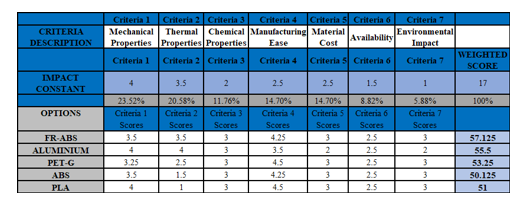
All the criteria after analysis, show that Polymer materials gain score to criteria like Cost, Availability, etc. Aluminium scores good in physical criteria. But the FR-ABS, gains advantage over Aluminium because it gets a high score in physical properties as well as other criteria as it is Polymer material.
???????B. Battery selection and Housing Design
- Factors we considered while Design of battery pack are:
a. Battery Selection: We considered two types of batteries in project namely cylindrical, pouch but our research can be extended for prismatic cells also in the future.
|
Aspect |
Cylindrical Cells |
Pouch Cells |
Prismatic Cells |
|
Shape |
Cylindrical |
Rectangular |
Rectangular |
|
Construction |
Metal casing with a central electrode |
Flexible pouch with stacked electrodes |
Rigid casing with stacked electrodes |
|
Energy Density |
Low |
Moderate to high |
Moderate to high |
|
Power Density |
Low to Moderate |
Moderate to High |
Moderate |
|
Size Range |
Small |
Small to medium |
Medium to large |
|
Cost |
Low to Moderate |
Moderate to high |
Moderate to high |
|
Manufacturing |
Established and widely used |
Requires specialized equipment |
Requires specialized equipment |
|
Safety |
Relatively safe |
Moderate safety precautions required |
Moderate safety precautions required |
|
Cycle Life |
low |
Moderate to high |
Moderate to high |
Table 8: Comparison table for Battery Selection
b. Cell Arrangement: Determine the arrangement of individual battery cells within the pack. Common configurations include series (increasing voltage) and parallel (increasing capacity). Consider factors like voltage requirements, desired capacity, and balancing of cells for uniform charging and discharging.
2, Case design, Modelling and Manufacturing
While designing a casing for we considered the factors which affect the design of 3D printing a product. We designed a case for the pouch and cylindrical cell geometry because those are the most commonly used type of cells in automotive industry.
a. Pouch Cell
- For pouch cell the case was designed in order that negative and the positive tabs face outside. The pouch fits between the casing in series.
- Equal spacing for insulation between cells tabs to avoid short circuiting and ultimately happening thermal runaway
- Optimum air flow between cells body surface to ensure heat transfer between the ambient air and heated surface of cells
b. Cylindrical Cell
- In Cylindrical cell casing design here should be minimum spacing of 3mm between the cells to allow ambient air flow between the cells and required heat transfer to maintain a cell optimum operating temperature.
- Busbar spacing according to the series-parallel connection and incorporating isolation between both terminals from short circuit and unwanted arcing.
- Geometric dimensioning and tolerancing for cells and studs in the primary integration structure for proper fasteners and fittings.
- Cells support bracing was made to support the cells from any kind of lateral forces or motion occurring due to vehicle motion.
For modelling, we designed a CAD model with taking the appropriate considerations of the factors like structural integrity, space for battery cells and connectors, cooling channels, and mounting points for attachment to the vehicle.
All these dimensions were provided in the respective data sheets of the cell and can be modified according the various geometries.
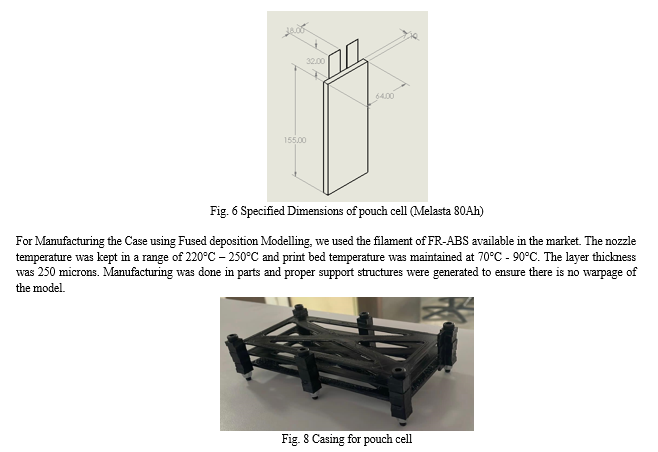

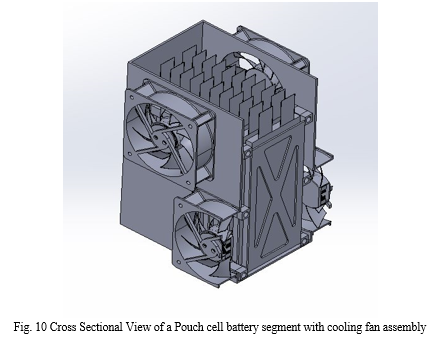

IV. FUTURE SCOPE
Furthermore, 3D printing offers unparalleled design freedom helping us in enhanced design flexibility, allowing for complex geometries and intricate internal structures that can optimize space utilization and performance. As additive manufacturing technologies advance, designers will have even greater flexibility in creating innovative battery pack casing designs.
Integration of Functional Features: 3D printing enables the integration of additional functional features directly into the battery pack casing. This could include embedded sensors for real-time monitoring of battery performance, built-in cooling channels for improved thermal management, or even conductive pathways for integrated electrical connections.
Another parameter we can explore is design through software driven solutions i.e., conducting CFD an thermal simulation to ensure there is a well-defined battery thermal management system.
Conclusion
Our final goal was to design a complete segment for both of the battery geometries. The entire segment was designed in a way that it can hold the complete stack of batteries to be housed, as well as any necessary clearances for wiring, connectors, and thermal management components. For battery installation and assembly, we ensured that there are proper access points that allow for easy insertion and removal of batteries without compromising the structural integrity of the casing. 1) For adequate ventilation and thermal management within the battery pack we included vents, channels and heat sinks to dissipate heat generated during battery operation and maintain optimal temperature levels. 2) Lastly a fastening mechanism was designed depend upon the type of cell being used. For the pouch cell we designed slots where M5 MS bolts can we inserted and removed using proper fastening tools. For cylindrical cells we used M4 MS bolts and support bracing was made to support the cells from any kind of lateral forces or motion occurring due to vehicle motion.
References
[1] Burton C. Suedel, Jongbum Kim, and Cynthia J. Banks. Comparison of the Direct Scoring Method and Multi-Criteria Decision Analysis for Dredged Material Management Decision Making. [2] Marcy Lowe, Saori Tokuoka, Tali Trigg and Gary Gereffi 2010 Lithium-ion Batteries for Electric Vehicles: THE U.S. VALUE CHAIN, October 5, 2010. [3] Lisa Li, Henry Kuang, Hui Wang, Sam Yang, Assembly System Configurator for Lithium-Ion Battery Manufacturing. 2017 The regents of the university of michigan, 2017 [4] Mahmoud M. Farag 1997 Materials Selection for engineering design (Prentice Hall Europe) [5] C. Alaoui, 2013, Solid-State Thermal Management for Lithium-Ion EV Batteries (IEEE Transactions on Vehicular Technology, Vol 62, issue 1) p. 98 [6] Comparative Study of the Sensitivity of PLA, ABS, PEEK, and PETG’s Mechanical Properties to FDM PrintingProcess Parameters [7] Hunt G. Electric vehicle battery test procedure manual. 2nd ed. MI, USA: United States Advanced Battery Consortium; 1996. [8] Riley RQ. In: Robert Q, editor. Automobile ride, handling and suspension designs. Riley Enterprises, LLC; 2011. ?http://www.rqriley.com/suspensn.htm?. [9] Lu L, Han X, Li J, Hua J, Ouyang M. A review on the key issues for lithium-ion
Copyright
Copyright © 2023 Gautam Kulkarni, Arya Mahajan, Anay Maheshwari. This is an open access article distributed under the Creative Commons Attribution License, which permits unrestricted use, distribution, and reproduction in any medium, provided the original work is properly cited.

Download Paper
Paper Id : IJRASET56595
Publish Date : 2023-11-09
ISSN : 2321-9653
Publisher Name : IJRASET
DOI Link : Click Here
 Submit Paper Online
Submit Paper Online

